Comets discovered in January 2016
C/2016A1 PANSTARRS
R. J. Wainscoat reports that an object found on on Jan. 1.54-1.57 UT with the 1.8-m Pan-STARRS1 telescope on Haleakala shows a clearly extended appearance but with no obvious tail (CBET 4232). Confirming CCD observations obtained by Wainscoat and P. Forshay with the 3.6-m Canada- France-Hawaii Telescope at Mauna Kea on Jan. 2.5 (measured by M. Micheli and J. Wainscoat) show a faint tail to the east-southeast; the red magnitude was measured as 18.5-18.6. After the object was posted on the Minor Planet Center's NEOCP webpage, A. Maury and J.-F. Soulier write that their stacked unfiltered CCD images taken on Jan. 3.2 UT with a 0.4-m f/8 Ritchey-Chretien reflector at San Pedro de Atacama, Chile, show a 9" coma and a possible tail 8" long in p.a. 150 deg; the red magnitude was measured to be 18.4-18.8. The available astrometry (spanning Jan. 1-5), the following preliminary parabolic orbital elements by G. V. Williams, and an ephemeris appear on MPEC 2016-A62.
T = 2017 Nov. 23.0754
Peri. = 10.4537
Node = 128.2487
q = 5.317378 AU
Incl. = 121.1302
e=1
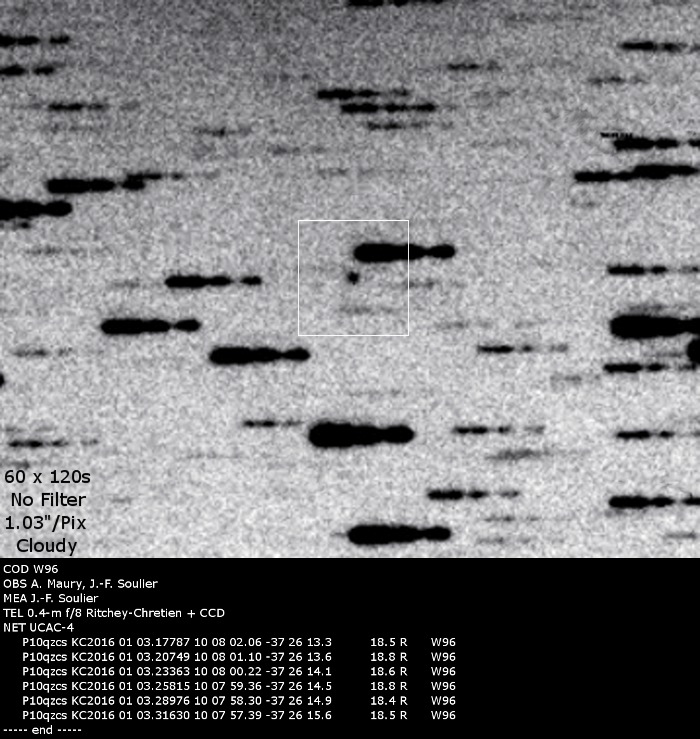
©Jean-Francois Soulier
P/2016 A2 Christensen
E. J. Christensen reports his discovery of a comet on CCD images taken with the Mount Lemmon 1.5-m reflector, the diffuse object displaying a coma of diameter approximately 8" with a short tail extending approximately 10" toward p.a. 300 deg (CBET 4233). The available astrometry (spanning Jan. 2-7), the following preliminary elliptical orbital elements by G. V. Williams, and an ephemeris appear on MPEC 2016-A63. The object turned to be a periodic comet with a period of 10.7 years.
T = 2015 Mar. 13.6675
Peri. = 130.2307
Node = 290.8555
q = 3.670402 AU
Incl. = 32.4538
a = 4.860067 AU
e = 0.244784
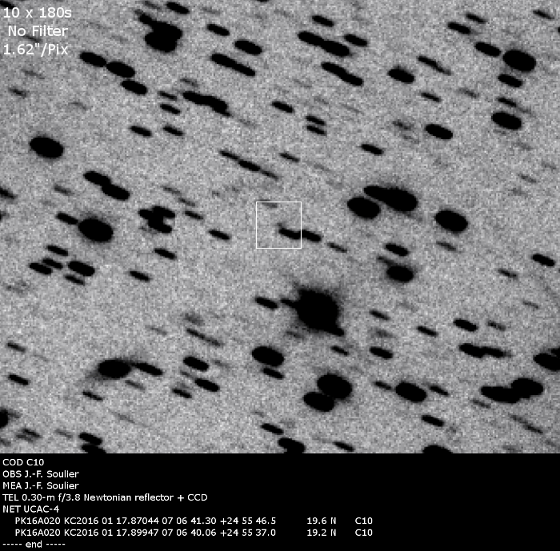
©Jean-Francois Soulier
P/2016A3 PANSTARRS
R. Weryk, E. Lilly, and R. Wainscoat report the discovery of an apparent comet in four w-band exposures taken on Jan. 4.54-4.57 UT with the 1.8-m Pan-STARRS1 telescope on Haleakala, with clear evidence of a short tail extending towards position angle 300 deg for approximately 4"(CBET 4234). The following preliminary parabolic orbital elements by G. V. Williams and an ephemeris appear on MPEC 2016-A64.
T = 2017 Apr. 2.1942
Peri. = 16.1829
Node = 180.7301
q = 3.107381 AU
Incl. = 9.0476
e=1.0
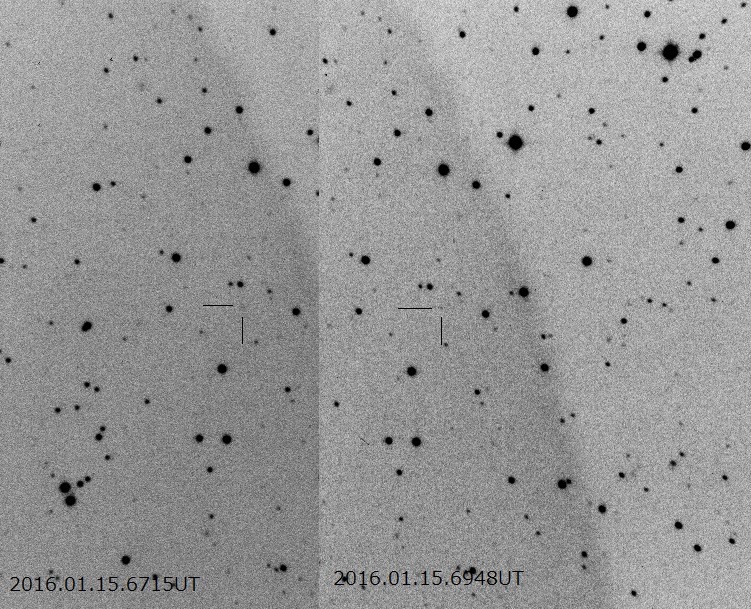
©Kunihiro Shima
C/2016 A5 PANSTARRS
R. Wainscoat reported that an object found on images taken on Jan. 9.5 with the 1.8-m Pan-STARRS1 telescope on Haleakala seem to show a very faint tail slightly south of west, but very much at the detection limit (CBET 4238). After the object was posted on the Minor Planet Center's PCCP webpage, CCD astometrists as H.Sato (Japan) elsewhere commented on the object's cometary appearance. The available astrometry, the following preliminary parabolic orbital elements by G. V. Williams, and an ephemeris appear on MPEC 2016-B09.
T = 2015 June 28.8486
Peri. = 319.7540
Node = 135.6304
q = 2.836940 AU
Incl. = 38.8556
e=1

C/2016A6 PANSTARRS
Another comet was discovered by PANSTARRS team with 1.8m telescope on Haleakala from images taken on Jan 13UT (CBET 4239). The object has an extended point-spread function (1".8) compared to adjacent stars (1".1-1".3; variable seeing) in stacked images, and there is a hint of an extension (possible tail) to the north. After the object was posted on the Minor Planet Center's PCCP webpage, CCD astometrists elsewhere have also noted the object's cometary appearance. The available astrometry (spanning Jan. 13-18), the following preliminary parabolic orbital elements by G. V. Williams, and an ephemeris appear on MPEC 2016-B34.
T = 2015 Nov. 6.9050
Peri. = 141.4491
Node = 300.2329
q = 2.417856 AU
Incl. = 121.0198
e=1.0
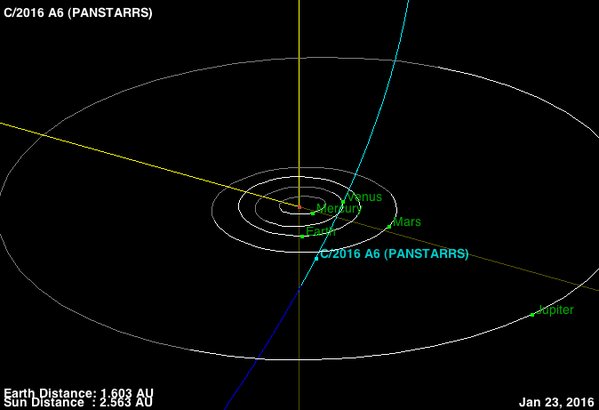
P/2016A7 PANSTARRS
E. Lilly, R. Weryk, and R. Wainscoat, Institute for Astronomy, University of Hawaii, report the discovery of an apparent comet in four w-band exposures taken on Jan. 14.7 UT with the 1.8-m Pan-STARRS1 telescope on Haleakala,the object has a marginally fuzzy appearance and a 21.5th magnitude (CBET 4241). After the object was posted on the Minor Planet Center's PCCP webpage, H. Sato (Tokyo, Japan) writes that the object to be strongly condensed with an outer coma 12" in diameter and no tail was detected. The available astrometry (spanning Jan. 14-22), the following preliminary elliptical orbital elements by G. V. Williams, and an ephemeris appear on MPEC 2016-B62.
T = 2016 Apr. 6.9156
Peri. = 8.9130
Node = 218.1219
Incl. = 17.2772
q = 1.985129 AU
e = 0.190896
a = 2.453489 AU
P = 3.84 years
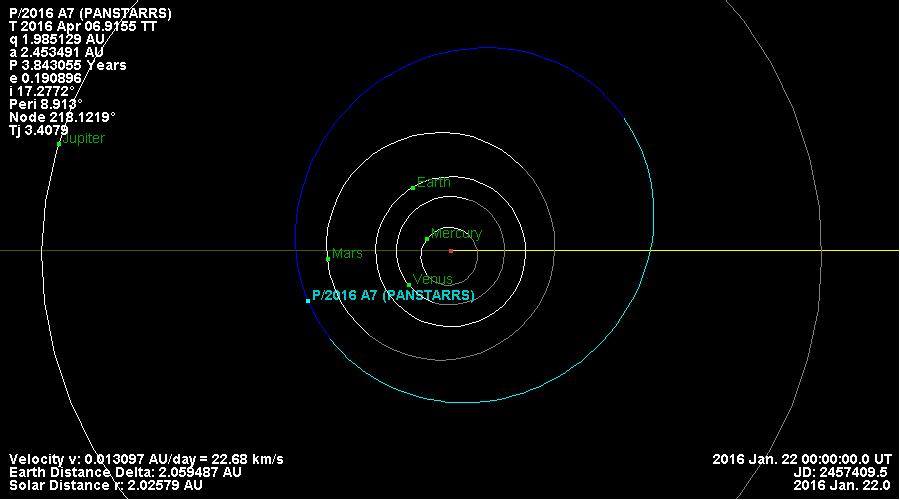
C/2016 A8 LINEAR
An apparently asteroidal object found on CCD images taken on Jan. 14 with the 3.5-m f/1, in the course of the LINEAR survey, has been found to show marginal cometary appearance by CCD astrometrists like E.Bryssinck, H.Sato and K.Sarneczky, elsewhere after the object was posted on the Minor Planet Center's PCCP webpage (CBET 4245). The available astrometry (spanning Jan. 14-29), the following preliminary elliptical orbital elements by G. V. Williams, and an ephemeris appear on MPEC 2016-B84.
T = 2016 Aug. 30.5009
Peri. = 129.8930
Node = 111.3228
Incl. = 148.2542
q = 1.894188 AU
e = 0.948139
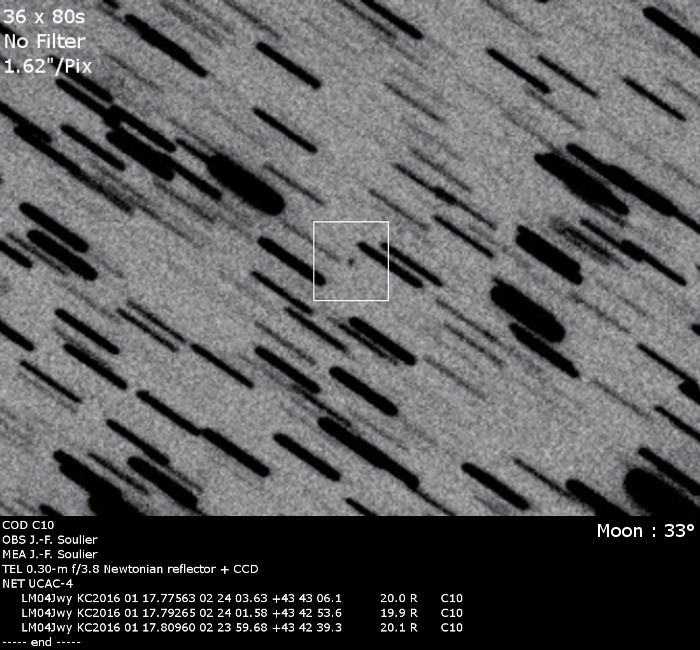
©Jean-Francois Soulier
C/2016B1 NEOWISE
J. Bauer, Jet Propulsion Laboratory, forwards a report from Emily Kramer of the discovery of another comet found on infrared images taken with the Near-Earth Object Wide-field Infrared Survey Explorer (or NEOWISE) on observations from Jan. 17-18 (CBET 4242). Bauer adds that follow-up observations were obtained by J. Masiero, A. Shugart, L. Magill, A. Lopez, and M. Gomez with the Gemini 8.0-m reflector (+ GMOS) at Cerro Pachon, Chile, on Jan. 22.3 UT that show an obvious coma of red mag 18.8-20.0 with a faint tail extending to the east- northeast. After the object was posted on the Minor Planet Center's PCCP webpage, R.Holmes (Ashmore, IL, USA) writes that CCD images taken by T. Linder and himself with an 0.61-m f/6.5 Dall-Kirkham astrograph at Cerro Tololo on Jan. 21.34-21.35 UT show a 10" coma without an obvious cometary tail on five stacked 20-s exposures; the magnitude (stated as V) was measured as 19.0-19.7. The available astrometry (spanning Jan. 17-22), the following preliminary parabolic orbital elements by G. V. Williams, and an ephemeris appear on MPEC 2016-B63.
T = 2016 Sept.19.6636
Peri. = 338.0745
Node = 239.4108
q = 4.272297 AU
Incl. = 47.4651
e=1.0
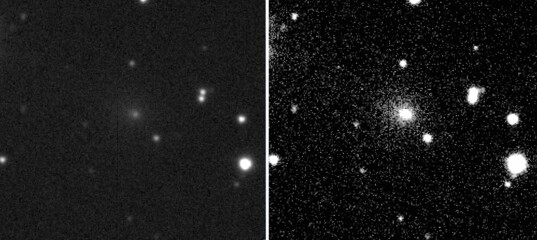
J.Masiero / Gemini Observatory/ AURA
